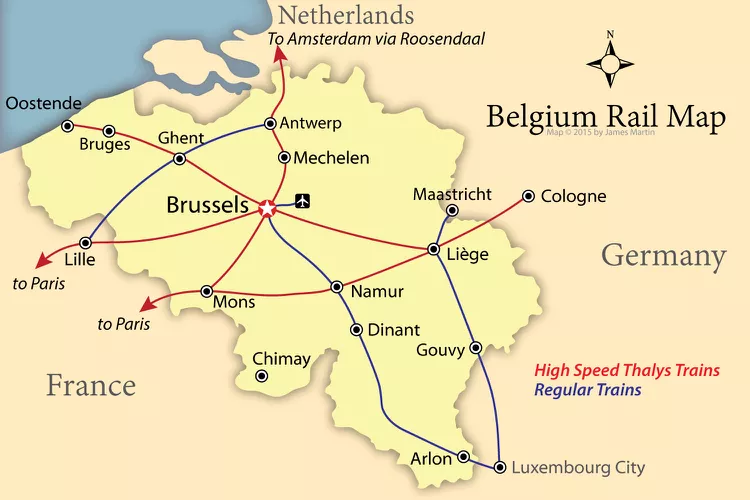Summary of Belgium Travel Highlights
- Belgium Tourism Map
- Belgium Cities and Towns
- Where to Stay
- What to Eat and Drink in Belgium
- Languages
- Transportation to and within Belgium
- Getting to Belgium – By Train
- When to Go
- Etiquette and Culture in Belgium
- Restaurants in Belgium
- Currency in Belgium
- Belgian Chocolate and Its Popularity
- Antwerp Central: The Railroad Cathedral
- Walking and Biking in the Belgian Countryside
Belgium Tourism Map Showing Rail Lines
One of the great things about visiting Belgium is its diminutive size and the interesting cities crammed together so they’re just a short train ride from each other. You won’t spend a lot of time (or money) getting from one destination to another. Plus, it’s very easy to get to London and Paris as well as other destinations in Germany, the Netherlands, and Luxembourg.
The Thalys high-speed train whisks you from Brussels to Paris in about an hour and a half. Brussels to London takes a little over two hours. You can be in Cologne, Germany from Brussels on the cheaper normal trains in under three hours.
Belgium Cities and Towns
The major cities popular with tourists include Brussels, Bruges, Ghent, and Antwerp, alongside smaller cities like Liège, Dinant, Damme, Mechelen, and Mons.
Belgium is also a focal point for World War I sites, many including remnants of the rather brutal trench warfare, such as the Trench of Death in Dixmude.
Where to Stay
Belgium offers a wide range of accommodations, including hotels near train stations, many of which are budget-friendly. There are also several hostels in larger cities like Brussels.
Self-catering accommodations are popular, providing options from small apartments to sprawling villas for larger families and groups. This can be a cost-effective alternative to traditional hotel stays.
Farm stays attract those who enjoy the rural environment; a stay at Hoeve Spreeuwenburg, for instance, is quite rewarding.
What to Eat and Drink in Belgium
Frites – Often misnamed “French” fries, these are a national favorite, typically served with mayonnaise.
Waterzooi – Meaning “simmering water,” this hearty stew features local fish or chicken enriched with vegetables and herbs, typically accompanied by butter, egg yolks, and cream.
Carbonnades – This classic dish consists of meat cooked with brown beer, epitomizing Belgian cuisine.
Belgian Endive – Known as white gold, this endive is often served braised.
Chocolate – Unsurprisingly, Belgian chocolate is world-renowned and a must-try when visiting.
Beer – Enthusiasts will enjoy a variety of local styles, including Lambic Ale, Abbey and Trappist Ale, Witbier, Sour Ale, and more.
Languages
The northern Flanders region speaks Dutch, whereas the southern Wallonia region predominantly speaks French. German is spoken in the East, near the German border. English is also widely spoken in tourist areas.
For those interested in picking up a few Dutch phrases, numerous online resources are available.
Transportation to and within Belgium
Brussels Airport is the only international airport in Belgium. Taxis are available outside the arrivals hall, providing a convenient transfer to the city center, with fares generally around €45.
Getting to Belgium – By Train
The Eurostar connects Brussels and London, while fast TGV trains link Brussels to Paris and Amsterdam.
The Belgian railway system is extensive, and the SNCB’s website offers information on routes and passes.
When to Go
Belgium enjoys a moderate climate with relatively brief and frequent rain. For more detailed weather information throughout the year, various resources are available for popular destinations.
Etiquette and Culture in Belgium
Understanding cultural habits is significant for visitors, especially if business is part of your agenda. Resources are available to assist in navigating common scenarios.
Restaurants in Belgium
Dining out in Belgium can be a sophisticated experience, though informal options such as bistros and café’s are readily available. While dining can be pricey, budget-friendly eateries like sandwich shops and pancake houses provide affordable alternatives.
Service charges are typically included in bills, and it’s common for Belgians to round up when determining tips.
Currency in Belgium
The currency used throughout Belgium is the Euro, which was valued at 44.3399 Belgian Francs upon its adoption.
Belgian Chocolate and How It Became Popular
After checking into your accommodation, you’re likely to encounter numerous chocolate shops within minutes. Belgium boasts over 2,130 chocolate shops and leads in per capita chocolate consumption.
During the 17th century, Spain’s rule brought chocolate to Belgium, initially enjoyed as a drink. The local enthusiasm led them to seek cocoa sources, including the Belgian Congo.
Neuhaus, Belgium’s first chocolate shop, opened in Brussels in 1857, and their products are still available today.
Antwerp Central: The Railroad Cathedral
:max_bytes(150000):strip_icc():format(webp)/railway-cathedral-56a3a3eb5f9b58b7d0d2f89d.jpg)
Antwerp’s central station stands out due to its magnificent architecture that dates back to 1895–1905. The station is surrounded by diamond and gold shops and features a stunning 44-meter high glass vault. Even if you aren’t catching a train, the station is worth a visit.
Walking and Biking in the Belgian Countryside
:max_bytes(150000):strip_icc():format(webp)/belgian-horses-56a3a3ee3df78cf7727e6467.jpg)
The flat terrain of the Belgian countryside is perfect for outdoor activities such as walking and biking. Numerous paths, previously used for tow paths, now serve as trails connecting major cities and towns.




